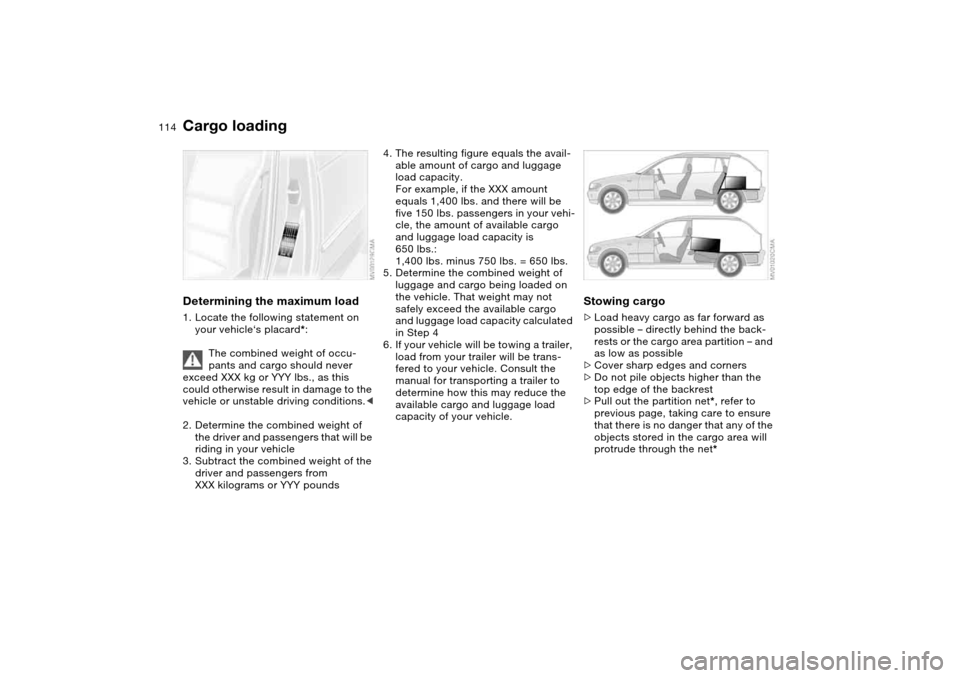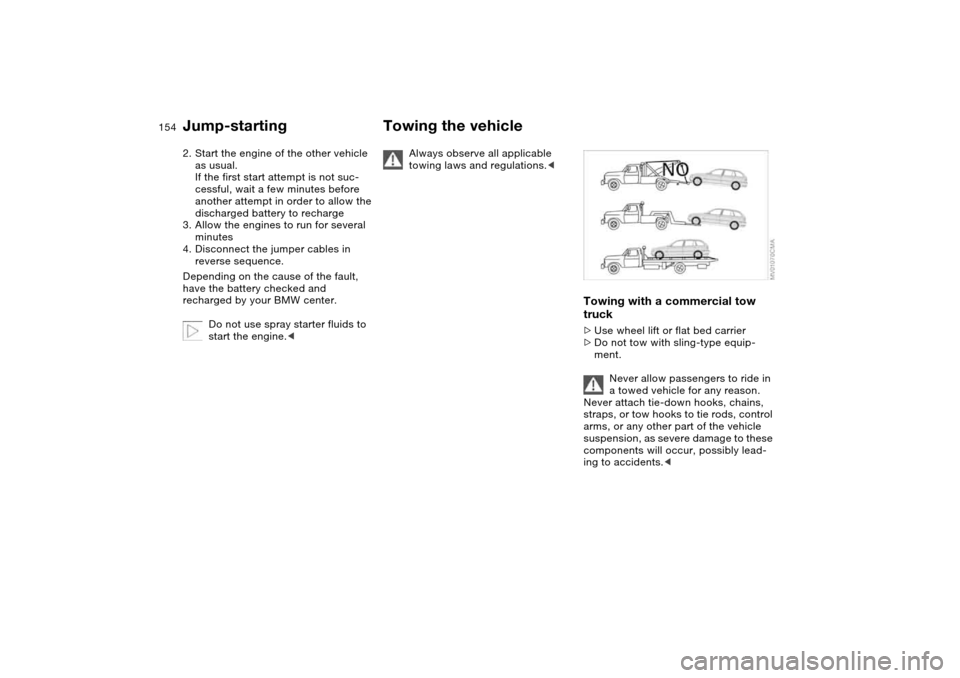2005 BMW 325XI TOURING towing
[x] Cancel search: towingPage 10 of 178

Contents
Operation, maintenance
Special operating instructions:
Break-in procedures120
General driving notes121
Antilock Brake System
(ABS)121
Brake system122
Wheels and tires:
Tire inflation pressure124
Tire condition124
Tire replacement125
Wheel and tire
combinations127
Winter tires127
In the engine compartment:
Hood129
Engine compartment
essentials130
Washer fluids132
Engine oil132
Coolant134
Brake fluid135
Maintenance:
The BMW Maintenance
System136
Laws and regulations:
California Proposition 65
warning138
OBD interface socket138
Owner service procedures
Replacement procedures:
Onboard tool kit142
Windshield wiper blades142
Lamps and bulbs143
Changing a wheel147
Run Flat tires*150
Battery151
Fuses151
Giving and receiving
assistance: Receiving assistance152
Jump-starting153
Towing the vehicle154
Technical data
Engine data160
Dimensions161
Weights162
Capacities163
Page 69 of 178

69
instance, downshifts that would
result in excessive engine speed can-
not be executed
>When you brake the car to a stop, the
transmission automatically shifts
down to first gear
>As speed diminishes, the transmis-
sion will shift down automatically,
without any action on your part, just
before the vehicle slows to below
each gear's minimum speed.
Available displaysR N 1 2 3 4 5 6
D1 D2 D3 D4 D5 D6
The currently engaged gear, the
selected mode, and any malfunctions
are displayed in the instrument cluster.Indicator lamp
If the indicator lamp comes on,
there is a malfunction in the
transmission system.
All selector lever positions can still be
engaged, but in the forward driving
positions only certain gears are actually
available when the vehicle is driven.
Avoid extreme loads and proceed to
the nearest BMW center.
For information on jump-starting and
towing the vehicle, refer to page 153.Warning toneAn acoustic signal sounds if the SMG
gearbox overheats; if possible you
should either stop or increase your pull-
away speed so that the system can
cool down.
Sequential manual gearbox SMG*
OverviewControlsMaintenanceRepairsDataIndex
Page 73 of 178

73
Available displaysP R N D SD M1 M2 M3 M4 M5Electronic transmission control
module
If the indicator lamp comes on,
there is a malfunction in the
transmission system.
Bring the vehicle to a stop. Move the
transmission selector lever to P. Set the
parking brake and turn the engine off –
ignition key to position 0.
Wait a few seconds, then start the
engine.
If the indicator lamp goes out after a
few seconds, normal transmission per-
formance has been restored. You may
continue to drive as usual.
If the indicator lamp does not go out,
you can place the selector lever in all
positions. However, the vehicle will now
only operate in 3rd and 4th gear.
If this happens, avoid extreme engine
loads and consult the nearest autho-
rized BMW center.
Never work in the engine com-
partment when a drive gear – for-
ward or reverse – is engaged. If you do
this, the vehicle could move.<
For towing or jump-starting, refer to the
information beginning on page 153.
Automatic transmission with Steptronic*
OverviewControlsMaintenanceRepairsDataIndex
Page 114 of 178

114
Determining the maximum load1. Locate the following statement on
your vehicle‘s placard*:
The combined weight of occu-
pants and cargo should never
exceed XXX kg or YYY lbs., as this
could otherwise result in damage to the
vehicle or unstable driving conditions.<
2. Determine the combined weight of
the driver and passengers that will be
riding in your vehicle
3. Subtract the combined weight of the
driver and passengers from
XXX kilograms or YYY pounds
4. The resulting figure equals the avail-
able amount of cargo and luggage
load capacity.
For example, if the XXX amount
equals 1,400 lbs. and there will be
five 150 lbs. passengers in your vehi-
cle, the amount of available cargo
and luggage load capacity is
650 lbs.:
1,400 lbs. minus 750 lbs. = 650 lbs.
5. Determine the combined weight of
luggage and cargo being loaded on
the vehicle. That weight may not
safely exceed the available cargo
and luggage load capacity calculated
in Step 4
6. If your vehicle will be towing a trailer,
load from your trailer will be trans-
fered to your vehicle. Consult the
manual for transporting a trailer to
determine how this may reduce the
available cargo and luggage load
capacity of your vehicle.
Stowing cargo>Load heavy cargo as far forward as
possible – directly behind the back-
rests or the cargo area partition – and
as low as possible
>Cover sharp edges and corners
>Do not pile objects higher than the
top edge of the backrest
>Pull out the partition net*, refer to
previous page, taking care to ensure
that there is no danger that any of the
objects stored in the cargo area will
protrude through the net*
Cargo loading
Page 154 of 178

154
2. Start the engine of the other vehicle
as usual.
If the first start attempt is not suc-
cessful, wait a few minutes before
another attempt in order to allow the
discharged battery to recharge
3. Allow the engines to run for several
minutes
4. Disconnect the jumper cables in
reverse sequence.
Depending on the cause of the fault,
have the battery checked and
recharged by your BMW center.
Do not use spray starter fluids to
start the engine.<
Towing the vehicle
Always observe all applicable
towing laws and regulations.<
Towing with a commercial tow
truck>Use wheel lift or flat bed carrier
>Do not tow with sling-type equip-
ment.
Never allow passengers to ride in
a towed vehicle for any reason.
Never attach tie-down hooks, chains,
straps, or tow hooks to tie rods, control
arms, or any other part of the vehicle
suspension, as severe damage to these
components will occur, possibly lead-
ing to accidents.<
Jump-starting
Page 155 of 178

155
Towing the vehicle with the front
axle raisedVehicles with automatic transmission:
1. Towing speed: maximum 45 mph /
70 km/h
2. Towing distance: maximum
90 miles/150 km.
Vehicles with sequential manual gear-
box SMG:
While the ignition is on, move the selec-
tor lever to position N, then turn off the
ignition.325xi: towing the vehicle with the
front or rear axle raised1. Place the transmission in Neutral
2. Switch off the engine
3. Towing speed:
max. 30 mph / 50 km/h
4. Towing distance:
max. 90 miles/150 km.
Remove the rear driveshaft for
longer towing distances with the
front axle lifted; remove the front drive-
shaft for towing over longer distances
with the rear axle lifted. Failure to com-
ply with this will result in damage to the
transfer box.<
Towing eyeletThe screw-in towing eyelet is stored in
the onboard tool kit; be sure that it
remains in the vehicle at all times. It can
be attached at the front or rear of the
vehicle. The towing eyelet should not
be used to pull a vehicle out of deep
snow, mud, sand, etc. Always observe
all applicable towing laws and regula-
tions.
Access to tow socketsFront:
Press out the cover panel with a screw-
driver inserted in the recess at the top.
Towing the vehicle
OverviewControlsMaintenanceRepairsDataIndex
Page 156 of 178

156
Rear:
Press out the cover panel with a screw-
driver inserted in the recess at the top.
Use only the towing eyelet sup-
plied with the vehicle and screw it
in firmly until it stops. Use the towing
eyelet for towing on paved roads only. If
you do not follow these instructions, the
towing eyelet could be torn out and
vehicle damage could occur. Never
attach tie-down hooks, chains, straps,
or tow hooks to tie rods, control arms,
or any other part of the vehicle suspen-
sion, as severe damage to these com-
ponents will occur, possibly leading to
accidents.<
Avoid staggered towing and be
careful that the towing strap is
taut before starting to drive the vehicle
doing the towing.<
Use only a nylon towing strap to tow
the vehicle, since the inherent resil-
ience of this material helps protect both
vehicles from sudden jerking move-
ments.
The towed vehicle should always
be the lighter of the two vehicles.
If this is not the case, it will not be pos-
sible to control vehicle handling.<
Tow-startingFor instructions on jump-starting, refer
to page 153.
Never attempt to use your vehicle to
push another car, since damage to the
energy-absorbing bumpers could
result.
Towing the vehicle
Page 169 of 178

Everything from A to Z
169
Disposal
oil 133
vehicle battery 151
Distance warning, refer to
Park Distance Control
(PDC) 85
Door key 30
Door lock 34
Doors
emergency operation 34
Draft-free ventilation 99, 103
Driving light, refer to Parking
lamps/Low beams 93
Driving notes 121
Dry air, refer to Air condi-
tioning mode 98, 102
DSC Dynamic Stability Con-
trol 86
indicator lamp 19, 86
DTC Dynamic Traction Con-
trol 86
indicator lamp 19, 86
Dynamic Brake Control
(DBC) 19, 121
indicator lamp 19
Dynamic Stability Control
(DSC) 19, 86
Dynamic Traction Control
(DTC) 86
indicator lamp 19, 86E
Electric glass sunroof 41
Electric power windows 40
Electrical accessories, fail-
ure 151
Electrical malfunction
automatic transmission
with Steptronic 73
door lock 34
driver's door 34
fuel filler door 24
glass sunroof 43
tailgate 36
Electronic Stability Program
(ESP), refer to Dynamic
Stability Control (DSC) 86
Emergency call 152
Emergency operation
doors 34
driver's door 34
fuel filler door 24
glass sunroof 43
Emergency release
tailgate 36
Emissions, minimum, refer
to Energy control 79
Energy control 79Engine
breaking in 120
data 160
electronics 19
indicator lamp 19
speed 79, 160
starting 63
switching off 65
Engine compartment 130
Engine coolant 134
adding 134
Engine oil
adding 133
additives, refer to Adding
engine oil 133
capacity 163
indicator/warning lamp 19
quality 133
viscosity 134
Engine oil consumption 132
Engine oil level 19
check 132
indicator/warning lamp 18
Engine oil pressure
indicator/warning lamp 18
Engine oil types 133
Engine output, refer to
Engine data 160
Engine speed 79, 160
Environmentally-friendly
driving, refer to Energy
control 79ESP Electronic Stability Pro-
gram, refer to Dynamic
Stability Control DSC 86
Exterior mirrors 52
Eyeglasses
compartment 107
Eyelet, towing 155
F
False alarm, refer to
Avoiding unintentional
alarms 39
Fastening the safety belts 48
Fault displays 81
First aid, refer to First-aid
kit 23
First-aid kit 23
Flashlight 106
Flashlight, refer to
Rechargeable
flashlight 106
Flat tire 147
Flat Tire Monitor 91
space-saver spare tire 147
Flat Tire Monitor 91
indicator lamp 18, 19, 92
Flat tire, refer to Tire condi-
tion 124
Floor panel, lifting 113
Fluid reservoir for washer
systems 132
OverviewControlsMaintenanceRepairsDataIndex